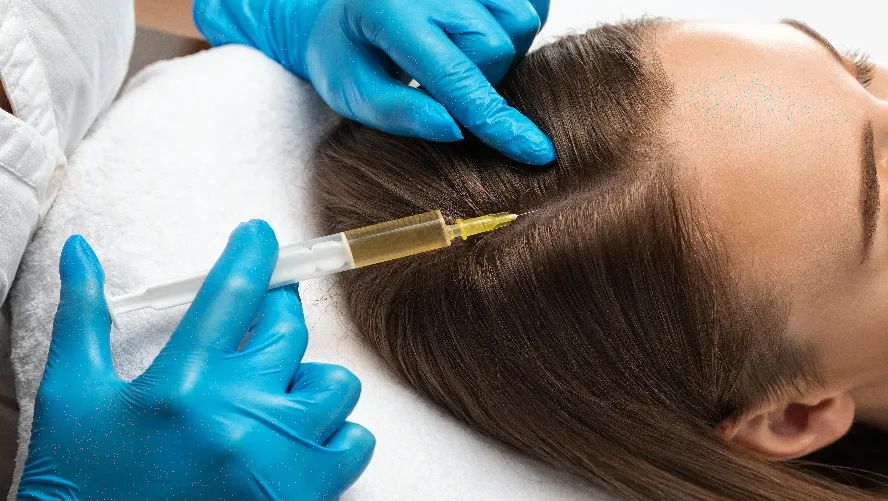PRP (Platelet-Rich Plasma) is a treatment method that utilizes plasma rich in platelets, derived from your blood, to rejuvenate the skin and promote healing. Associate Professor Tuğba Falay Gür explains the process, benefits, and details of PRP therapy, helping patients achieve a younger, healthier, and more aesthetic appearance.
What is PRP Therapy?
PRP therapy is based on the principle of concentrating and injecting plasma from a patient’s blood into targeted areas for treatment. This plasma contains growth factors from platelets that stimulate skin rejuvenation, collagen production, and overall skin health improvement. PRP is widely used for facial rejuvenation and hair loss treatments, among other aesthetic applications.
Purposes and Goals
The main goal of PRP therapy is to support the body’s natural healing processes to achieve a younger, healthier, and more aesthetic look. Key objectives include:
- Supporting Skin Renewal: Accelerating the regeneration of skin cells for a youthful and vibrant appearance.
- Boosting Collagen Production: Stimulating collagen and elastin production to enhance skin firmness and elasticity.
- Reducing Signs of Aging: Minimizing fine lines, wrinkles, and sagging skin.
- Decreasing Hair Loss: Strengthening hair follicles to control hair loss and promote growth.
- Improving Acne Scars: Reducing the appearance of scars and blemishes caused by acne.
- Enhancing Overall Skin Health: Correcting uneven pigmentation for a balanced skin tone.
How PRP Therapy Works
PRP therapy involves enriching the plasma obtained from a patient’s blood with platelets. The process includes the following steps:
- Blood Collection: A small amount of blood is drawn from the patient.
- Centrifugation: The blood is processed in a centrifuge to separate the platelet-rich plasma (PRP) from other components.
- PRP Preparation: The concentrated plasma is prepared for injection.
- Injection: The prepared PRP is injected into the targeted areas using fine needles.
- Healing Process: Growth factors in PRP stimulate cell regeneration and collagen production in the skin.
Treatment Process
The PRP treatment process generally includes:
- Assessment: A specialist evaluates the skin type, signs of aging, hair loss, and treatment needs.
- Preparation: The treatment area is cleaned and sterilized.
- Blood Collection and Processing: Blood is drawn, and PRP is prepared.
- Injection: PRP is carefully injected into the designated areas. Patients may feel mild pricking or burning sensations during the procedure.
- Recovery: Mild redness or swelling may occur post-treatment, but these effects are temporary.
- Aftercare: Specific care instructions, such as moisturizing and sun protection, are provided to support recovery.
Benefits
The main benefits of PRP therapy include:
- Natural and Safe: Since PRP is derived from the patient’s blood, the risk of allergic reactions is low.
- Minimally Invasive: Does not require surgery, reducing risks and allowing quick recovery.
- Versatile Application: Effective for facial rejuvenation, hair loss treatment, acne scar reduction, and more.
- Quick Results: Noticeable improvements can be achieved with regular treatment sessions.
- Increased Collagen Production: Enhances the skin’s natural elasticity and firmness, leading to a more youthful appearance.
- Strengthened Hair Follicles: Reduces hair loss and promotes healthier, fuller hair.
Risks and Side Effects
PRP therapy is generally safe, but some side effects may occur:
- Redness and Swelling: Temporary redness and swelling in the treated area.
- Mild Pain or Discomfort: Slight pain or discomfort during or after the procedure.
- Bruising and Bleeding: Minor bruising or bleeding at injection sites.
- Infection Risk: Increased risk of infection if sterile conditions are not maintained.
- Allergic Reactions: Rare allergic reactions to the solution may occur.
- Peeling and Crusting: Mild peeling or crusting of the skin may develop.
Who is it Suitable For?
PRP therapy may be suitable for:
- Individuals with Signs of Aging: Those with fine lines, wrinkles, and sagging skin.
- People Experiencing Hair Loss: Those seeking to strengthen hair follicles and reduce hair loss.
- Individuals with Pigmentation Issues: Those aiming to reduce sunspots, melasma, and uneven pigmentation.
- People with Acne and Scars: Those looking to diminish the appearance of acne scars and blemishes.
- Young Adults Focused on Skin Health: Those prioritizing preventive care to delay aging signs.
- Aesthetic Enthusiasts: Individuals desiring a younger, firmer, and healthier skin appearance.
Results and Expectations
Post-treatment, the following changes can be observed:
- Youthful and Radiant Skin: Reduction in aging signs for a vibrant glow.
- Enhanced Skin Elasticity and Firmness: Increased collagen production tightens and firms the skin.
- Even Skin Tone: Pigmentation irregularities are reduced for a balanced complexion.
- Smooth Skin Texture: Acne scars and texture irregularities are diminished for smoother skin.
- Healthier Hair Appearance: Hair loss is reduced, and hair looks fuller and healthier.
Cost and Number of Sessions
The cost of PRP therapy depends on factors such as the number of sessions, treatment areas, and individual health conditions. Multiple sessions are typically required for long-lasting results. A personalized treatment plan and cost analysis will be provided after a consultation with Associate Professor Tuğba Falay Gür.
Precautions and Prevention: General Measures
To maximize the results of PRP therapy and maintain skin health, consider these precautions:
- Sun Protection: Use broad-spectrum sunscreen to protect against harmful UV rays.
- Skin Care: Follow a gentle skincare routine, including moisturizers, and avoid irritants.
- Balanced Nutrition: Maintain a diet rich in antioxidants and omega-3 fatty acids to support skin health.
- Stress Management: Practice yoga, meditation, or breathing exercises to reduce stress.
- Hydration: Drink plenty of water to support overall health and skin hydration.
Skin Care and Lifestyle
Proper skincare and a healthy lifestyle are essential for enhancing the effects of PRP therapy:
- Gentle Cleansers: Use hypoallergenic cleansers to avoid skin irritation.
- Moisturizing: Hydrate the skin regularly to maintain its barrier and healing process.
- Adequate Sleep: Ensure proper rest to support the body’s natural recovery.
- Regular Exercise: Physical activity improves blood circulation, contributing to healthier skin.
Appointments and Contact
For more information about PRP therapy, to explore treatment options, and to receive expert advice, contact us through our communication channels. Benefit from Associate Professor Tuğba Falay Gür’s expertise to achieve younger, healthier, and more radiant skin.
Note: PRP therapy should only be performed under the supervision of an experienced and qualified doctor. A thorough pre- and post-treatment evaluation with your doctor is essential.







